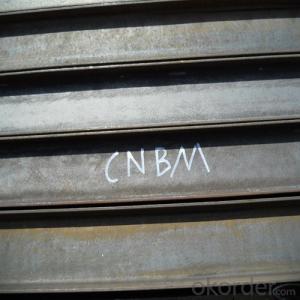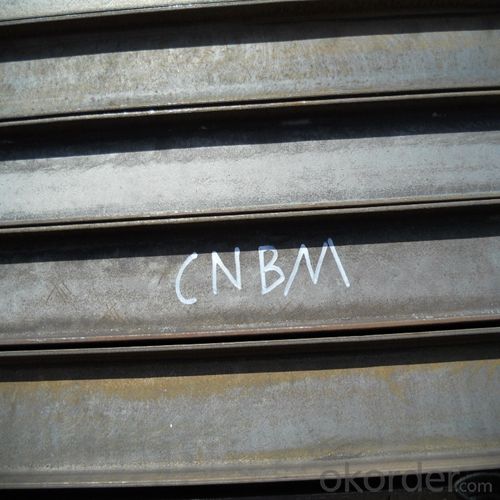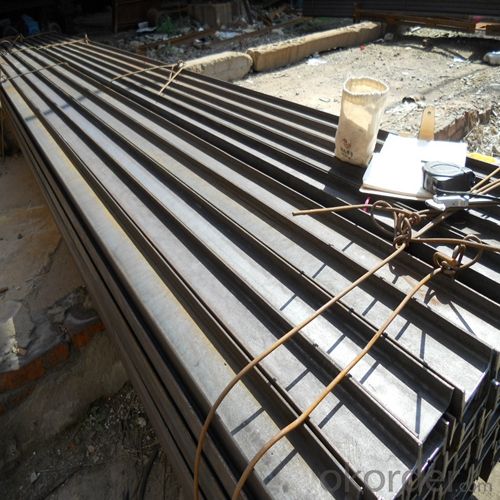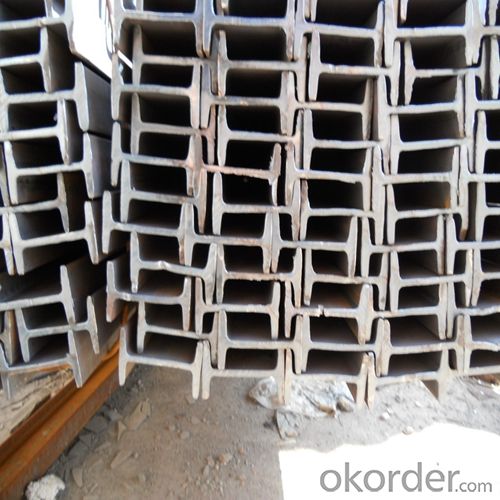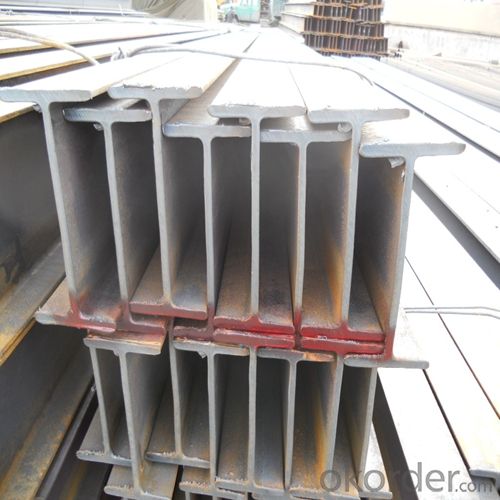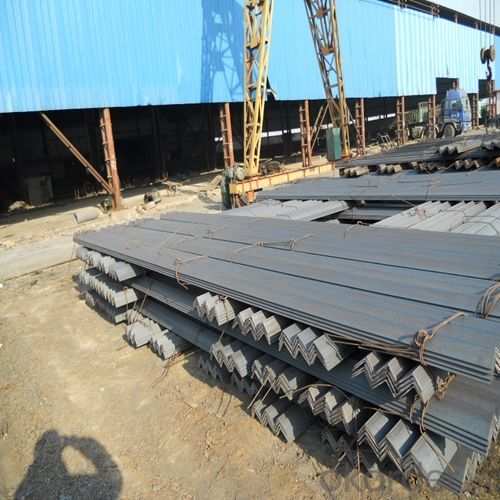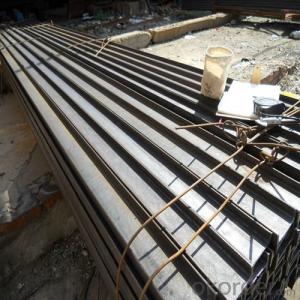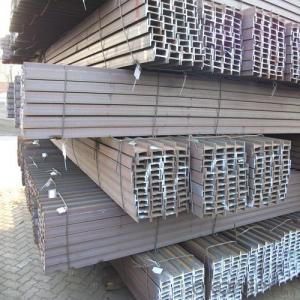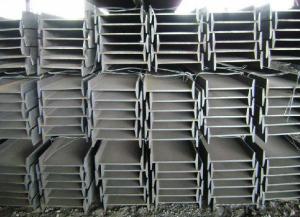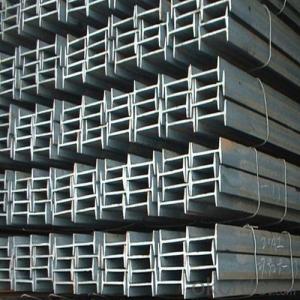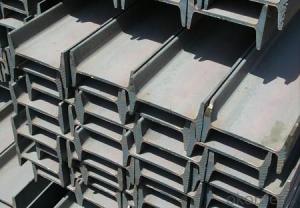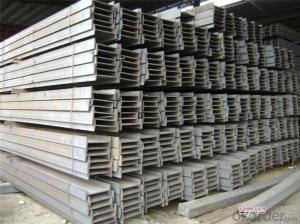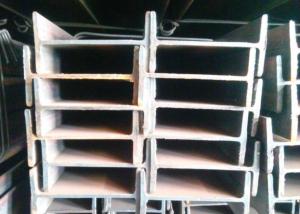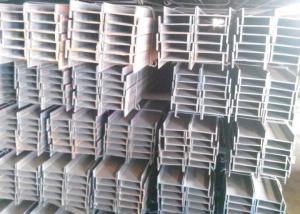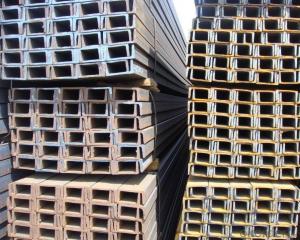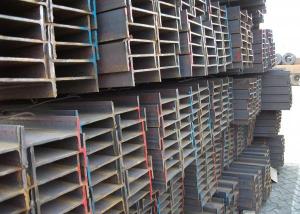Hot Rolled Steel I-Beam IPE IPEAA EN10025 S235JR with Good Price
- Loading Port:
- Tianjin
- Payment Terms:
- TT OR LC
- Min Order Qty:
- 100 m.t.
- Supply Capability:
- 30000 m.t./month
OKorder Service Pledge
OKorder Financial Service
You Might Also Like
Product Description:
Specifications of High Quality Steel I Beam
Standard: EN10025, ASTM, GB Standard, DIN, JIS, etc.
Material of High Quality Steel I Beam:Q235, SS400, A36, S235JR, S275JR, etc
Alloy No. | Grade | C | Mn | S | P | Si |
Q235 | B | 0.12%-0.20% | 0.3%-0.7% | <=0.045% | <=0.045% | <=0.3% |
Sizes: 80MM-270MM
Section | Standard Sectional Dimensions(mm) | ||||
h | b | s | t | Mass Kg/m | |
IPE80 | 80 | 46 | 3.80 | 5.20 | 6.00 |
IPE100 | 100 | 55 | 4.10 | 5.70 | 8.10 |
IPE120 | 120 | 64 | 4.80 | 6.30 | 10.40 |
IPE140 | 140 | 73 | 4.70 | 6.90 | 12.90 |
IPE160 | 160 | 82 | 5.00 | 7.40 | 15.80 |
IPE180 | 180 | 91 | 5.30 | 8.00 | 18.80 |
IPE200 | 200 | 100 | 5.60 | 8.50 | 22.40 |
IPE220 | 220 | 110 | 5.90 | 9.20 | 26.20 |
IPE240 | 240 | 120 | 6.20 | 9.80 | 30.70 |
IPE270 | 270 | 135 | 6.60 | 10.20 | 36.10 |
IPEAA80 | 80 | 46 | 3.20 | 4.20 | 4.95 |
IPEAA100 | 100 | 55 | 3.60 | 4.50 | 6.72 |
IPEAA120 | 120 | 64 | 3.80 | 4.80 | 8.36 |
IPEAA140 | 140 | 73 | 3.80 | 5.20 | 10.05 |
IPEAA160 | 160 | 82 | 4.00 | 5.60 | 12.31 |
IPEAA180 | 180 | 91 | 4.30 | 6.50 | 15.40 |
IPEAA200 | 200 | 100 | 4.50 | 6.70 | 17.95 |
Length: 5.8M, 6M, 9M, 12M or as the requriements of the clients
Descriptions of Metal Structural Steel I-Beam
Grade:SS400,A36,S235JR,S275JR,Q235B. Size:80mm---270mm
1.Origin: Tangshan city . 2.Steel Material :Q195-Q235. ASTM A36, SS400.ect
3.Standard: GB ,JIS ,BS, ASTM, DIN. 4.Size: Meet standard size or as buyer's request .
5.Invoicing on theoretical weight or actual weight as customer request 6.Length: 5.8M, 6M, 8M, 9M, 12M.
Q235B
Chemical composition
Alloy No. | Grade | C | Mn | S | P | Si |
Q235 | B | 1.12%-0.20% | 0.3%-0.7% | <=0.045% | <=0.045 | <=0.3 |
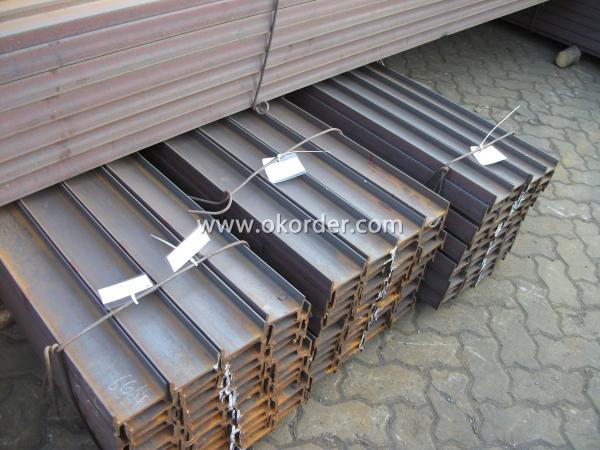
Applications of Metal Structral Steel I-Beam
1.Support structures 2.Pre-engineered buildings 3.Prefabricated structure
4.It is widely used in various building structures and engineering structures such as roof beams, bridges, transmission towers, hoisting machinery and transport machinery, ships, industrial furnaces, reaction tower, container frame and warehouse etc.
Packing & Devilivery of Metal Structual Steel I-Beam
1.Packing: All the metal structural steel I- Beams will be tied by wire rod in bundles and loaded in containers or in bulk cargo. All the bundles will be hung the markings of CNBM, which include the trademark, size, material, length, etc. We can also hang the lables according to the requriements of the customers.
2.Each bundle not more than 3.5MT for bulk vessel; less than 3 MT for container load
3.Tag mark: there will be tag mark tied up on the bundles. The information usually including supplier logo and name, product name, made in China, shipping marks and other information request by the customer. If loading by container the marking is not needed, but we will prepare it as customer request.
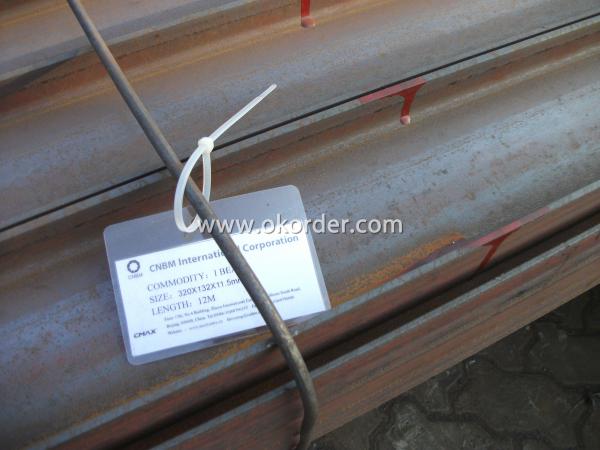
4.Delivery time: Within 30 days after receiving original L/C at sight or deposit by T/T, all the metal structural steel I-Beams will be transported to the port of loading and prepared to load.
5.Transportation: the goods are delivered by truck from mill to loading port, the maximum quantity can be loaded is around 40MTs by each truck. If the order quantity cannot reach the full truck loaded, the transportation cost per ton will be little higher than full load.
Payment terms of Metal Structural Steel I-Beam
1).100% irrevocable L/C at sight. 2).30% T/T prepaid and the balance against the copy of B/L.
3).30% T/T prepaid and the balance against L/C
Others terms of Metal Structural Steel I-Beam
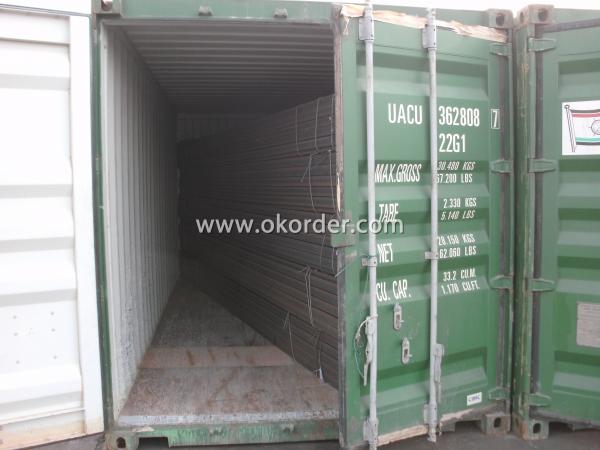
- Q: Are steel I-beams suitable for agricultural or industrial buildings?
- Yes, steel I-beams are highly suitable for both agricultural and industrial buildings. They offer excellent strength, durability, and load-bearing capacity, making them ideal for supporting heavy equipment and machinery commonly found in these sectors. Additionally, steel I-beams are resistant to pests, fire, and various environmental factors, ensuring long-lasting structural integrity.
- Q: What are the common safety considerations when working with steel I-beams?
- To ensure the well-being of workers and prevent accidents when working with steel I-beams, it is important to take several common safety considerations into account. These considerations comprise the following: 1. Personal Protective Equipment (PPE): Workers must wear appropriate PPE, such as hard hats, safety glasses, steel-toed boots, and high visibility vests. This is necessary to protect against potential hazards, including falling objects or flying debris. 2. Proper Lifting Techniques: Due to the weight of steel I-beams, it is crucial to use proper lifting techniques to prevent back injuries or strains. Workers should receive training on these techniques and use mechanical aids, such as cranes or forklifts, whenever possible, for handling and moving the I-beams. 3. Secure Storage and Transport: It is essential to securely store and transport steel I-beams to prevent tipping or falling. This can be achieved by using appropriate restraints, straps, or chains to keep the I-beams in place. 4. Fall Protection: Given that steel I-beams are often installed at elevated heights, fall protection becomes a critical safety consideration. Workers must utilize appropriate fall protection equipment, like harnesses and lanyards, when working at heights or on scaffolding to prevent falls and serious injuries. 5. Adequate Training: Workers involved in steel I-beam work should undergo proper training on safe practices, including handling, installation, and securing of the I-beams. This training should also encompass emergency procedures and how to respond to potential hazards or accidents. 6. Inspections and Maintenance: Regular inspections are necessary to identify any signs of damage, corrosion, or structural issues that may compromise the integrity of steel I-beams. Any deficiencies should be promptly addressed, and damaged I-beams should be replaced to prevent potential accidents. 7. Communication and Signage: Clear communication and signage should be implemented to alert workers and others in the vicinity about the presence of steel I-beams and associated hazards. This can include warning signs, barricades, and designated walkways to ensure everyone is aware of the potential risks and takes appropriate precautions. By addressing these common safety considerations, employers can establish a safer work environment when working with steel I-beams, thereby reducing the risk of accidents, injuries, and fatalities.
- Q: Shear strength of No. 16 I-beam
- Is the index of material strength, mechanical strength, mechanical properties of steel I-beam is divided, tensile strength, compressive strength, flexural strength, shear strength and end bearing strength, due to material and thickness and different grades.
- Q: What are the common connections details for steel I-beams?
- The connection details for steel I-beams can vary depending on the specific application and design requirements. However, structural steel construction commonly employs several connection methods. One method frequently used is the welded connection, where the flanges and web of the I-beam are welded to the supporting structure, such as columns or beams. Welded connections offer exceptional strength and rigidity, making them suitable for heavy-duty applications with high loads. Another method is the bolted connection, where bolts are utilized to connect the I-beam to the supporting structure. Bolted connections provide flexibility during installation and allow for easy disassembly if necessary. They are often employed in applications that foresee adjustability or future modifications. Furthermore, there exist hybrid connection methods that combine both welding and bolting. These connections strike a balance between the strength and rigidity of welded connections and the flexibility of bolted connections. Hybrid connections are commonly chosen when specific design requirements call for a combination of these characteristics. It is crucial to emphasize that the specific connection details for steel I-beams must adhere to local building codes and industry standards. Structural engineers and design professionals typically determine the appropriate connection method based on factors such as load requirements, structural stability, and construction feasibility.
- Q: How are steel I-beams measured?
- When measuring steel I-beams, their height, width, and weight per unit length are typically taken into account. The height, also referred to as the beam depth, is measured from the top to the bottom of the vertical part of the I-beam. The width, known as the flange width, is measured from one end of the horizontal section to the other. These measurements play a vital role in determining the overall size and load-bearing capacity of the I-beam. Apart from the height and width, the weight per unit length is also measured to determine the mass of the I-beam. This is crucial in calculating the structural strength and load-carrying capacity of the beam. To ensure uniformity in measurements and facilitate easy comparison and selection of I-beams for different construction purposes, industry standards such as ASTM or EN are typically followed. These standards guarantee consistency and enable straightforward evaluation and choice of I-beams. It should be noted that steel I-beams can come in various sizes and shapes, including wide flange beams, H-beams, and S-beams, among others. Each type of beam has its own unique measurements and specifications. Therefore, it is indispensable to refer to the manufacturer's specifications or engineering guidelines when accurately measuring and selecting the appropriate steel I-beam for a specific construction project.
- Q: What are the cost implications of using steel I-beams in construction?
- The cost implications of using steel I-beams in construction can vary depending on several factors. Firstly, the initial cost of steel I-beams is generally higher compared to alternative building materials such as wood or concrete. This is because steel is a premium material known for its strength, durability, and load-bearing capabilities, which makes it a preferred choice for supporting heavy structures. However, it is important to note that steel I-beams tend to have a longer lifespan and require less maintenance compared to other materials, which can contribute to cost savings in the long run. Additionally, the cost of using steel I-beams in construction is influenced by the size and weight of the beams required for the project. Larger and heavier beams will naturally cost more due to the increased amount of steel needed and the associated transportation and handling costs. Another cost consideration is the installation process. Steel I-beams require specialized equipment and skilled labor for proper installation, which can add to the overall project expenses. However, the speed and ease of installation can offset these costs by reducing construction time and labor hours. Furthermore, steel is a versatile material that can be easily recycled. This contributes to the sustainability aspect of using steel I-beams and can result in potential cost savings through recycling incentives or reduced waste disposal fees. Overall, while the upfront cost of using steel I-beams in construction may be higher, the long-term benefits such as durability, reduced maintenance, and potential sustainability advantages can outweigh the initial investment. It is important to carefully evaluate the specific project requirements, structural needs, and budget constraints to determine the most cost-effective solution.
- Q: What are the different types of steel used in manufacturing I-beams?
- There are several types of steel commonly used in manufacturing I-beams, including carbon steel, alloy steel, and stainless steel. Carbon steel is the most common type and is known for its strength and affordability. Alloy steel contains additional elements such as manganese, chromium, and nickel to enhance its strength, hardness, and corrosion resistance. Stainless steel, on the other hand, is highly resistant to corrosion and is often used in environments where rust is a concern. The specific type of steel used in manufacturing I-beams depends on the desired properties and requirements of the application.
- Q: Can steel I-beams be used in coastal areas?
- Yes, steel I-beams can be used in coastal areas. Steel is a durable and reliable construction material that can withstand the harsh conditions often found in coastal environments, such as high winds, saltwater, and humidity. However, it is important to select the appropriate type of steel and apply protective coatings to prevent corrosion. Stainless steel or galvanized steel are commonly used in coastal areas due to their resistance to rust and corrosion. Additionally, regular inspection and maintenance are necessary to ensure the structural integrity of the steel I-beams in coastal areas.
- Q: Which bearing capacity is stronger?
- On both sides of I-beam symmetrical shape, the stress is not eccentric, and channel forming easy, cheap, and their "strong bearing capacity, which is closely related with their size and shape, a special mechanical bending section coefficient We - shape coefficient in mechanics of materials, according to the size of the check material the manual, the who, who is that the" strong bearing capacity ", because the maximum stress of B beam and the bending moment is proportional to M, and the cross-section coefficient is inversely proportional to We.
- Q: Can steel I-beams be used for conveyor supports?
- Indeed, conveyor supports can make use of steel I-beams. These beams are frequently employed in construction and industrial settings because of their robustness and resilience. They boast exceptional load-bearing capacities, rendering them suitable for assisting hefty machinery and equipment, such as conveyors. The design of the I-beam facilitates an even distribution of weight and ensures structural stability, crucial attributes for conveyor systems that transport materials over lengthy distances or at high velocities. Furthermore, steel I-beams can be readily tailored and installed to fulfill particular conveyor support needs, establishing them as a dependable option for conveyor systems across different industries.
Send your message to us
Hot Rolled Steel I-Beam IPE IPEAA EN10025 S235JR with Good Price
- Loading Port:
- Tianjin
- Payment Terms:
- TT OR LC
- Min Order Qty:
- 100 m.t.
- Supply Capability:
- 30000 m.t./month
OKorder Service Pledge
OKorder Financial Service
Similar products
Hot products
Hot Searches
Related keywords
